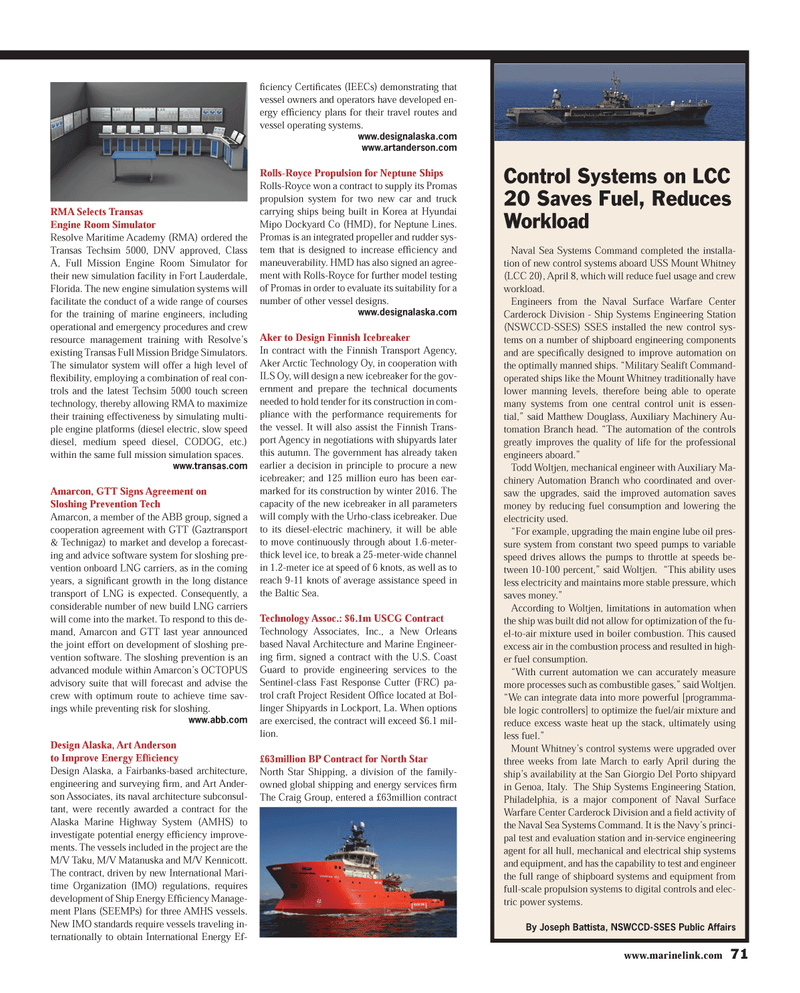
Page 71: of Maritime Reporter Magazine (May 2013)
Energy Production & Transportation
Read this page in Pdf, Flash or Html5 edition of May 2013 Maritime Reporter Magazine
www.marinelink.com 71Control Systems on LCC 20 Saves Fuel, Reduces Workload Naval Sea Systems Command completed the installa-tion of new control systems aboard USS Mount Whitney (LCC 20), April 8, which will reduce fuel usage and crew workload. Engineers from the Naval Surface Warfare Center Carderock Division - Ship Systems Engineering Station (NSWCCD-SSES) SSES installed the new control sys-tems on a number of shipboard engineering components and are speciÞ cally designed to improve automation on the optimally manned ships. ?Military Sealift Command-operated ships like the Mount Whitney traditionally have lower manning levels, therefore being able to operate many systems from one central control unit is essen-tial,? said Matthew Douglass, Auxiliary Machinery Au- tomation Branch head. ?The automation of the controls greatly improves the quality of life for the professional engineers aboard.?Todd Woltjen, mechanical engineer with Auxiliary Ma- chinery Automation Branch who coordinated and over- saw the upgrades, said the improved automation saves money by reducing fuel consumption and lowering the electricity used.?For example, upgrading the main engine lube oil pres-sure system from constant two speed pumps to variable speed drives allows the pumps to throttle at speeds be-tween 10-100 percent,? said Woltjen. ?This ability uses less electricity and maintains more stable pressure, which saves money.? According to Woltjen, limitations in automation when the ship was built did not allow for optimization of the fu-el-to-air mixture used in boiler combustion. This caused excess air in the combustion process and resulted in high-er fuel consumption.?With current automation we can accurately measure more processes such as combustible gases,? said Woltjen. ?We can integrate data into more powerful [programma- ble logic controllers] to optimize the fuel/air mixture and reduce excess waste heat up the stack, ultimately using less fuel.?Mount Whitney?s control systems were upgraded over three weeks from late March to early April during the ship?s availability at the San Giorgio Del Porto shipyard in Genoa, Italy. The Ship Systems Engineering Station, Philadelphia, is a major component of Naval Surface Warfare Center Carderock Division and a Þ eld activity of the Naval Sea Systems Command. It is the Navy?s princi- pal test and evaluation station and in-service engineering agent for all hull, mechanical and electrical ship systems and equipment, and has the capability to test and engineer the full range of shipboard systems and equipment from full-scale propulsion systems to digital controls and elec-tric power systems.By Joseph Battista, NSWCCD-SSES Public Affairs RMA Selects Transas Engine Room SimulatorResolve Maritime Academy (RMA) ordered the Transas Techsim 5000, DNV approved, Class A, Full Mission Engine Room Simulator for their new simulation facility in Fort Lauderdale, Florida. The new engine simulation systems will facilitate the conduct of a wide range of courses for the training of marine engineers, including operational and emergency procedures and crew resource management training with Resolve?s existing Transas Full Mission Bridge Simulators. The simulator system will offer a high level of ß exibility, employing a combination of real con- trols and the latest Techsim 5000 touch screen technology, thereby allowing RMA to maximize their training effectiveness by simulating multi- ple engine platforms (diesel electric, slow speed diesel, medium speed diesel, CODOG, etc.) within the same full mission simulation spaces.www.transas.com Amarcon, GTT Signs Agreement on Sloshing Prevention Tech Amarcon, a member of the ABB group, signed a cooperation agreement with GTT (Gaztransport & Technigaz) to market and develop a forecast- ing and advice software system for sloshing pre-vention onboard LNG carriers, as in the coming years, a signiÞ cant growth in the long distance transport of LNG is expected. Consequently, a considerable number of new build LNG carriers will come into the market. To respond to this de- mand, Amarcon and GTT last year announced the joint effort on development of sloshing pre- vention software. The sloshing prevention is an advanced module within Amarcon?s OCTOPUS advisory suite that will forecast and advise the crew with optimum route to achieve time sav-ings while preventing risk for sloshing. www.abb.com Design Alaska, Art Anderson to Improve Energy Ef Þ ciencyDesign Alaska, a Fairbanks-based architecture, engineering and surveying Þ rm, and Art Ander- son Associates, its naval architecture subconsul- tant, were recently awarded a contract for the Alaska Marine Highway System (AMHS) to investigate potential energy ef Þ ciency improve- ments. The vessels included in the project are the M/V Taku, M/V Matanuska and M/V Kennicott. The contract, driven by new International Mari-time Organization (IMO) regulations, requires development of Ship Energy Ef Þ ciency Manage- ment Plans (SEEMPs) for three AMHS vessels. New IMO standards require vessels traveling in-ternationally to obtain International Energy Ef- Þ ciency Certi Þ cates (IEECs) demonstrating that vessel owners and operators have developed en-ergy ef Þ ciency plans for their travel routes and vessel operating systems. www.designalaska.com www.artanderson.com Rolls-Royce Propulsion for Neptune Ships Rolls-Royce won a contract to supply its Promas propulsion system for two new car and truck carrying ships being built in Korea at Hyundai Mipo Dockyard Co (HMD), for Neptune Lines. Promas is an integrated propeller and rudder sys-tem that is designed to increase efÞ ciency and maneuverability. HMD has also signed an agree- ment with Rolls-Royce for further model testing of Promas in order to evaluate its suitability for a number of other vessel designs. www.designalaska.com Aker to Design Finnish Icebreaker In contract with the Finnish Transport Agency, Aker Arctic Technology Oy, in cooperation with ILS Oy, will design a new icebreaker for the gov- ernment and prepare the technical documents needed to hold tender for its construction in com-pliance with the performance requirements for the vessel. It will also assist the Finnish Trans- port Agency in negotiations with shipyards later this autumn. The government has already taken earlier a decision in principle to procure a new icebreaker; and 125 million euro has been ear- marked for its construction by winter 2016. The capacity of the new icebreaker in all parameters will comply with the Urho-class icebreaker. Due to its diesel-electric machinery, it will be able to move continuously through about 1.6-meter- thick level ice, to break a 25-meter-wide channel in 1.2-meter ice at speed of 6 knots, as well as to reach 9-11 knots of average assistance speed in the Baltic Sea. Technology Assoc.: $6.1m USCG Contract Technology Associates, Inc., a New Orleans based Naval Architecture and Marine Engineer- ing Þ rm, signed a contract with the U.S. Coast Guard to provide engineering services to the Sentinel-class Fast Response Cutter (FRC) pa-trol craft Project Resident OfÞ ce located at Bol- linger Shipyards in Lockport, La. When options are exercised, the contract will exceed $6.1 mil-lion. £63million BP Contract for North Star North Star Shipping, a division of the family-owned global shipping and energy services Þ rm The Craig Group, entered a £63million contract MR #5 (66-74).indd 71MR #5 (66-74).indd 715/2/2013 10:57:38 AM5/2/2013 10:57:38 AM

 70
70

 72
72
